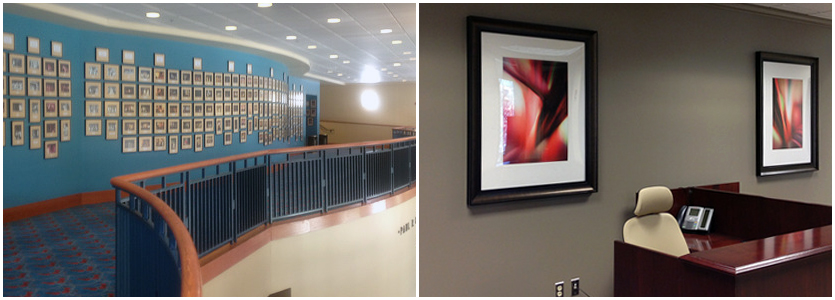Framing original art
“What is the best way to frame original art done on paper?”
First, you are framing an original that cannot be replaced. This means that you need to frame it in a manner that will keep it from being harmed by light, moisture or external damage.
Types of artwork done on paper include watercolor, pastel, charcoal, pencil, pen and ink, just to name a few.
In an earlier article I discussed the effect that light and moisture have on paper. We will now discuss how to use proper framing material to correctly frame your artwork once and enjoy it for decades.
There are three important parts to preserve the art…Glazing (glass or acrylic), matboard and mounting.
MOUNTING
Art needs to be mounted on an acid-free mounting board. This will provide a barrier for the art from behind. The art is mounted on this surface with “hinges”. The hinging material needs to be acid-free and completely removable, leaving no residue on the back of the art. Be sure to ask your framer what material they use for a “hinge mount”. For most hinge mounts two hinges at the top of the art is all you need. You do not place hinges on the sides or the bottom because the art needs to “hang” on the mounting board and behind the matboard. Back in the day cardboard was commonly used in framing treatments. Feel behind your current frame for ridges…they signal corrugation which means CARDBOARD!
MATBOARD
Matboard also needs to be acid-free. Rag matboard is the best. What a matboard does, besides creating a border between the frame and the artwork, is to provide a space between the glazing and the image. Have you ever seen a photograph get stuck to the glass? That is what usually happens when the glass rests on top of the image.
Since matboard generally comes in contact with your art being acid-free to insures there is no damage to the art. One quick way to determine if your current art has acid-free matboards is if the bevel edge is pristine white or discolored (yellow or brownish). If your current matboards are discolored consider having them changed. There are black core mats that are acid-free.
GLAZING – GLASS OR ACRYLIC
To protect your artwork from the effects of light you should use a glazing that filters out the ultra violet (UV) light. These days special glazing will filter 98% – 99% of the UV light. Conservation or museum glass are the two most common. In the acrylic arena OP3 and Optium are the two best choices. The price of quality glass has come down to a point where it only costs about 25% more to get the “good stuff.” By blocking the UV light your artwork will not fade and retain its look for years. After all isn’t that what it is all about!
ASSEMBLY
At Custom Framing Made Simple we mount the art on the acid-free mounting board, place the acid-free matboard over the art, place the glazing material on top of the matboard and wrap the edges in acid-free tape. This insures a quality environment in which the art can reside and live a happy life while providing you with decades of viewing enjoyment.
A good rule of thumb is to ask yourself…”Do I want my art to stay the way it is now?” The answer usually is yes. Make sure that your framer uses acid-free/archival material thus insuring the best possible protection for your artwork/investment.
At Custom Framing Made Simple we strive to protect and preserve your memories and investments.
Later we will discuss how to choose the right color matboard(s) and style of frame.
ENJOY YOUR ARTWORK…FRAME THEM AND HANG THEM!
Richard and Susan Koechlein
Custom Framing Made Simple
804-744-6490
www.customframingmadesimple.com


Share This